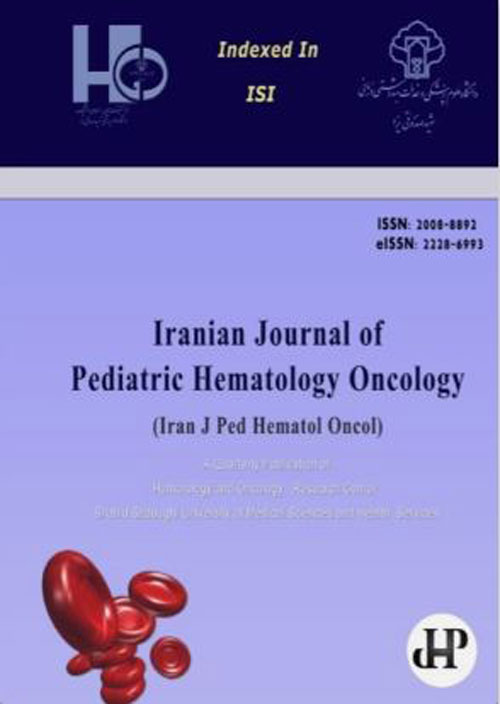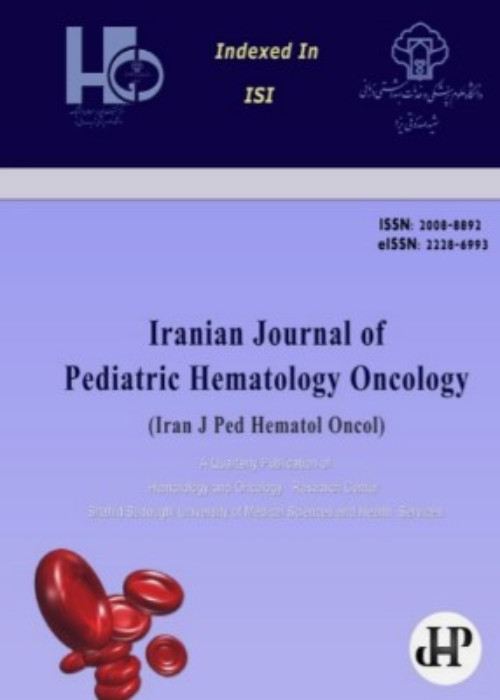فهرست مطالب

Iranian Journal of Pediatric Hematology and Oncology
Volume:11 Issue: 3, Summer 2021
- تاریخ انتشار: 1400/04/27
- تعداد عناوین: 7
-
-
Pages 148-157Background
Dysregulation of LncRNA antisense non-coding RNA in the INK4 locus (ANRIL) expression is implicated in pathogenesis and disease progression of a variety of cancer types. However, the expression level of ANRIL in pediatric patients with B-cell precursor acute lymphoblastic leukemia (BCP-ALL) has not been elucidated, yet. The present study is an attempt to evaluate the expression level of ANRIL at different clinical stages in pediatric patients with BCP-ALL.
Materials and MethodsThis case-control study was conducted in Tehran, Iran on peripheral blood samples obtained at diagnosis, complete remission, and relapse phases from a total of 50 pediatric BCP-ALL patients who were admitted to Mahak Hospital and Rehabilitation Complex, and Rasul Akram Hospital. The ANRIL expression analysis was performed by the quantitative real-time polymerase chain reaction (qRT-PCR) method. To test the statistical significance, a nonparametric Mann-Whitney U test was used.
ResultsThe mean fold-changes of ANRIL gene expression in newly diagnosed patients were [31.51 (18.28 to 44.75)] compared to the control group [1.06 (0.73 to 1.38)] indicating significant overexpression (P<0.001). ANRIL fold-changes significantly declined following achievement of complete remission [1.24 (0.80 to 1.69)] compared to the newly diagnosed patients (p<0.001) and increased as the patients experienced relapse [285.4 (269.70 to 301) (P<0.001)].
ConclusionsLncRNA ANRIL may contribute to BCP-ALL pathogenesis and disease progression; casting new light on the application of ANRIL as a potential biomarker or therapeutic target in BCP-ALL.
Keywords: ANRIL long non-coding RNA, Gene expression, Precursor B-cell lymphoblastic leukemia -
Pages 158-171Background
In Côte d’Ivoire, as in most developing countries, the reference values of hematological indices currently in use come from data collected from populations living in industrialized countries. The aim of this study was to determine variations in the childchr('39')s blood count in Cote dchr('39')Ivoire.
Materials and MethodsThis descriptive cross-sectional study has focused on 310 children (172 girls and 138 boys) aged 5 to 11 years selected from three municipalities of Abidjan. Blood samples were taken from each child in order to assess the parameters of the blood count.
ResultsThe results revealed that the means of the different hematological parameters (red blood cells, hemoglobin, hematocrit, white blood cells, neutrophils, eosinophils, monocyte, mean corpuscular volume, mean corpuscular hemoglobin and mean corpuscular hemoglobin concentration) were in accordance with the normal physiological reference values from the literature apart lymphocyte. The rate of lymphocytes (51.3 ± 0.5) was higher overall. All the parameters did not indicate significant differences between girls and boys (p > 0.05) except mean corpuscular volume, and mean corpuscular hemoglobin that were statistically different by sex (p < 0.05). The percentage of having a rate of haemoglobin lower than 11.5 decreased significantly (p˂0.005) when the age increased. In addition, the rate of hemoglobin and hematocrit increased slightly starting from the age of 8 years. There is a significant difference (p < 0.05) in hemoglobin level between girls and boys in the age group of 9 years. Leukopenia is observed in a minority of children in the age groups of 5, 6, 7, 8, and 10 years.
ConclusionSome hematological parameters were different from other data published in the literature, which suggested a local development of reference values for children.
Keywords: Blood count, Children, Hematological -
Pages 172-182Background
Umbilical cord blood hematopoietic stem cells (UCB-HSCs) are an attractive source for transplantation. The generation of megakaryocyte-committed cells could lead to shorten period of thrombocytopenia after HSCs transplantation. Platelet lysate (PL) unlike fetal bovine serum (FBS) can prevent immune problems as well as avert transmission of certain diseases to the recipient. In this study, the authors aimed to assess the effect of PL on UCB CD34+ cells expansion and megakaryocyte differentiation.
Materials and MethodsIn this experimental study, PL prepared and the subsequent isolation of UCB CD34+ cells were done by magnetic cell sorting. The isolated cells were cultivated in Iscove’s Modified Dulbecco’s medium (IMDM) supplemented with PL or FBS. Cell expansion was evaluated using Trypan blue. Furthermore, Flow cytometry using monoclonal antibodies (CD41-FITC and CD42b-PE) and the expression of specific genes including GATA1, GATA2, FLI1, NFE2, and RUNX1 via real-time PCR were performed to evaluate the megakaryocyte differentiation.
ResultsThe results showed that PL insignificantly enhanced UCB CD34+ cell expansion (32.83± 8.47 fold in FBS and 41.67± 10.31 fold in PL containing media). Besides, flow cytometry results showed that expression of CD41 was increased markedly (37.81± 4.78 fold in FBS and 45.78 ± 7.37 in PL containing media, P-value <0.05) but the elevation of CD42b (10.53 ± 2.13 and 13.20 ± 2.06 in FBS and PL containing media, respectively) was not significant (P-value = 0.051). The results of real-time PCR demonstrated a notable increase in GATA binding protein 1 (1.58, P-value <0.01), GATA binding protein 2 (2.45, P-value <0.001), RUNX family transcription factor 1 (1.60, P-value <0.01), Fli-1 proto-oncogene (1.87, P-value <0.001) in PL supplemented media, however, the increase of Nuclear Factor-Erythroid 2 gene expression was not significant in PL supplemented media (P-value = 0.11).
ConclusionPL improved UCB CD34+ cells expansion and megakaryocyte differentiation compared to FBS.
Keywords: Cord Blood Stem Cell Transplantation, Hematopoietic Stem Cells, Megakaryocyte Progenitor Cells, Platelet-Derived Growth Factor -
Pages 183-191Background
Eβ Thalassemia is characterized by clinical heterogeneity ranging from Non-Transfusion Dependent Thalassemia (NTDT) to Transfusion Dependent Thalassemia (TDT) state, causing management challenges for the clinicians, especially in the pediatric population. Therefore, this study was conducted to give an overview of the clinical profile and management in a tertiary care center.
Materials and MethodsThis is a retrospective observational study on the clinical profile of 48 patients with Eβ Thalassemia, after ethical approval. Clinical and biochemical parameters of enrolled patients were entered in pre-designed proforma. The clinical phenotypes of these patients were classified based on the Sripichai scoring system.
ResultsThe mean age of subjects at presentation was 3.3±2.8 years (M: F=3.8:1). On presentation, 25 (52.02%) patients had severe disease. Their mean age and initial mean hemoglobin at diagnosis were 2.5±1.3 years and 4.9±0.8 g/dl, respectively. They had a relatively larger spleen (p=0.16) and liver size (p=0.67). They were treated as TDT. Twenty-three patients were managed as the NTDT group at baseline. During follow-up period 19 out of 23 patients in the NTDT group (82.6%) were continued to be managed as the NTDT whereas the other four out of 23, required regular transfusion for a short duration. Serum Ferritin was <1000 ng/l in 78 % of patients in NTDT group as compared to 48% in TDT group (p<0.05). Endocrine complications were present 8% in the TDT group. Correlation of severity of clinical manifestation and laboratory findings were done using Chi-square test and T-test.
ConclusionIn the present study, the proper standardized classification of disease severity, helped in the management of these patients. It was found that detailed clinical knowledge regarding the pathophysiology, genetic modifiers, and complications along with close and careful monitoring of these patients based on clinical scores helps the pediatricians to classify these patients for their appropriate management.
Keywords: Clinical profile, Eβ-Thalassemia, Genotype, Phenotype -
Pages 192-197Background
β-thalassemia, a severe form of anemia, is an inherited blood disorder characterized by growth retardation, splenomegaly, and bone abnormalities. Complications related to treatment-induced iron overload also affect the quality of life of patients with major β-thalassemia. Some recent studies indicated cerebral hemodynamic disorders and increased risk of stroke in these patients. The aim of this study was to evaluate mean flow velocity (MFV) in some cerebral arteries of patients with major thalassemia using transcranial Doppler ultrasonography.
Materials and MethodsIn this cross-sectional study, 26 patients with major thalassemia were investigated. The definitive diagnosis was based on serum hemoglobin electrophoresis. Transcranial Doppler ultrasonography was performed in patients and MFV of internal carotid, anterior cerebral, and middle cerebral. Posterior cerebral arteries were measured. Demographic characteristics, duration of treatment, number of blood transfusions per month, the interval between the last blood transfusion, and the ultrasonography were recorded and analyzed statistically.
ResultsTen female and 16 male patients participated in this study. Results showed that 57.7% of patients had a hemodynamic abnormality in at least one vessel. The abnormality was significantly higher in the anterior and middle cerebral arteries (p<0.001 and p=0.005, respectively). Among the variables evaluated, age was significantly associated with hemodynamic dysfunction. This relationship remained significant after using the logistic regression analysis (p=0.0267).
ConclusionsSome patients with major thalassemia have a cerebral hemodynamic abnormality. Aging is associated with the higher frequency of this abnormality.
Keywords: Major thalassemia, Cerebral, Hemodynamic -
Pages 198-210Background
Cancer is the main cause of death in developed countries and the second main cause of death in developing countries. The aim of this study was to review the occupational risk factors and cancer incident in Iran.
Materials and Methodsthis present systematic review was done based on Preferred Reporting Items for Systematic Reviews and Meta-Analyses (PRISMA) guidelines on Persian articles with no time limits in publication and collected from January 2019 to April 2019 from Sid, Magiran and Google Scholar Databases. Some search terms including “job” or “occupation” “occupational exposure” or “cancer” or “neoplasm were used.
ResultsA total number of 103 articles were detected. After applying the inclusion and exclusion criteria, finally 18 studies remained in this systematic review with 13897 sample size and 7187 diagnosed patients. Most included studies researched on non-melanoma skin as the most studied cancer and sunlight exposure as the most carcinogenic reported occupational risk factor. Among included researches, only four studies were directly related to occupational cancer with 1837 sample size and 604 diagnosed various cancers in workers that focused on kidney, bladder and mesothelioma cancers (Pleural mesothelioma and Perivascular mesothelioma) .The results showed that, the cancer was reported in some occupations more than others.
ConclusionMost included researches reported skin cancer and exposure to sunlight as the most studied cancer and occupational risk factor respectively. As regard to importance of effective risk factors on cancer incidence , identification and control of occupational risk factor in the work environment should be a main key element of national cancer control program in countries specially developing countries. So it is recommended to develop the researches in field of occupational cancer in Iran.
Keywords: Exposure, Neoplasms, Occupational, Risk factor -
Pages 211-215
Thrombotic Thrombocytopenic Purpura (TTP) is a rare microangiopathic disorder characterised by the pentad of microangiopathic hemolytic anemia, thrombocytopenic purpura, neurologic abnormalities, fever, and renal disease. Decreased production and/or activity of ADAMTS13 is the cause of this disorder. ADAMTS13 is a metalloproteinase which is responsible of the cleavage of high weight multimers of von Wilebrand factor. Its acquired form is usually seen in adults and is due to antibody formation against the enzyme. But even rarer familial and relapsing forms (Upshow-Scholman syndrome) are due to enzyme underproduction and can be seen in pediatric age group. Here, the authors reported two unrelated cases of familial TTP from Guilan province in the north of Iran.
Keywords: ADAMTS13, Hemolytic anemia, Thrombotic Thrombocytopenic Purpura


